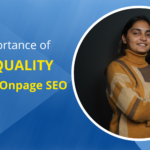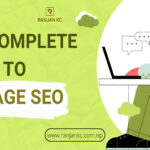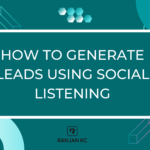Nearly as long as the internet has been accessible to the general public, search engine optimization (SEO) has existed. Since its inception, businesses have utilized it to expand their reach, attract new audiences, increase website traffic, disseminate information, and promote growth.
But what exactly is SEO, and how has it evolved since the days of stuffing pages with backlinks and keywords?
SEO has developed into a complex and technological strategy that is based on online user behavior over time. In its current iteration, high-quality websites are guaranteed to appear at the top of search engine result pages by using both on-page and off-page optimization strategies.
However, what exactly is on-page SEO strategies, and how can digital marketers employ them to benefit their business or clients? To discover everything you need to know about current SEO best practices, continue reading this blog.
Understanding On-Page SEO
All on-site methods you can use to guarantee a webpage will rank on a SERP are included in on-page SEO. Additionally, it may influence how well that page ranks. How does it manage to do this?
The more on-page SEO optimization you accomplish, the more traffic you’ll get to your website and the more relevant that traffic will be. It uses content and technical features to increase the quality of a page. To improve your page ranking, on-page SEO can be applied to a wide range of technical features of a website, such as:
- Title tags
- Headings
- URL structure
- Alt text for images
- Site speed
- Internal links
- Meta descriptions
- Responsiveness
Technical Best Practices for On-Page SEO
These on-page SEO technical best practices, in our view, are simple to implement and provide the best results for your content.
Employ title tags
Title tags are HTML components that can be used to specify a webpage’s name. They are shown on SERPs as the clickable result title. Each title tag needs to be distinct, explain what the page is about, include a keyword, and be no longer than 60 characters.
Use headlines that are relevant and optimized.
For the best results, headings—the names you offer your content—should be in the H1 format. While it is possible to enhance headings using keywords, avoid stuffing them with them. Instead, concentrate on using useful and illustrative language. The same recommended practices can be used with subheadings (H2 through H6) to split up material, but avoid using the same terms or phrases repeatedly. For ideas, look at our blog post on creating compelling headlines.
Consider your URL structure.
When search engines evaluate a page’s relevance to a query, your URL structure is crucial, and it should be descriptive of the page’s subject. As long as they are pertinent, keywords can also be used to optimize URLs. Instead of https://www.ranjankc.com.np/blog/123456/, an acceptable URL structure would be https://www.ranjankc.com.np/guide-to-social-media-marketing-in-nepal/.
Add alt text
Alt text (alternative text), though often used to describe images to website users who can’t see them, gives search engines more information about an image. Where a result, your alt texts should be 125 characters or fewer in length, specific and descriptive of the image content, and optimized with a keyword or phrase, as necessary.
Prioritize page load speed
Because slow-loading pages have significant bounce rates (47% of users anticipate a site to load in less than two seconds and 40% will depart after three), page load speed is crucial. As a result, slow-loading pages receive a worse rating from search engines, so it’s critical to guarantee a quick page load time. Test and evaluate your page performance if you’re unsure of how your site ranks with google page speed insight.
Include relevant internal links
Internal links not only make it simple for users to navigate across your website, but they also help search engines better understand your website and index your pages, which will raise your ranking. Every page on your website should, at the very least, connect back to the homepage and the page that corresponds to the category or subcategory.
Add Meta description
Meta descriptions are succinct but vivid summaries of a page’s content that complement title tags and explain to online viewers why they should read your content rather than someone else’s. The meta description, which can be found underneath the title and URL, should not exceed 160 characters.
Make better use of responsive design
A design component called responsiveness makes sure that your page will work properly on both desktop and mobile devices. As more and more people utilize mobile devices for internet search, this will continue to be a crucial feature.
Conduct research and add keywords.
Since keywords may be incorporated into all these on-page strategy to help the correct people find you at the right moment, they serve as the glue that holds your on-page strategy together in SEO. Keywords must be well studied, chosen with care, and integrated naturally and seamlessly into content in order to be effective.
The Effect of Content on On-Page SEO
Although the technical elements of on-page SEO are critical, content is one of the most significant components since it drives visitors to your website.
Not just any content, though, will do. Web users of today seek out content that is pertinent, captivating, instructive, and meets a need or provides a solution. To put it another way, people must want to consume the material you have produced, which can include a variety of widely used content kinds, like:
- Blogs
- Web page copy
- Videos
- Infographics
- Podcasts
- Whitepapers
- EBooks
- Interviews
- Case studies
- Original research
- Reviews
- Instructional articles
- Quizzes and poles
To avoid creating content that requires a login, copyrighted material, or specific slide shows, keep in mind that people must be able to link to the information you make.
It’s crucial that any content you create and distribute is original (unless you state that on the piece). Use these methods and tools to look for duplicate content if you’re unsure.
In the end, you want to create content that can be shared and reshared to gain additional viewers or maybe become viral.
Final thoughts on on-page SEO
As web user and online customer behavior evolves, search engine optimization best practices are constantly changing. At the moment, the best method for SEO is to have a sound plan in place that addresses both on- and off-page aspects.
Quality content and ensuring that the technical parts of the site have been optimized for speed, efficiency, and keywords are the essential priorities in on-page. Beside these factors tracking the keywords ranking using google analytics is important in order to know the status of traffic, sources, behavior of visitors and so on.



